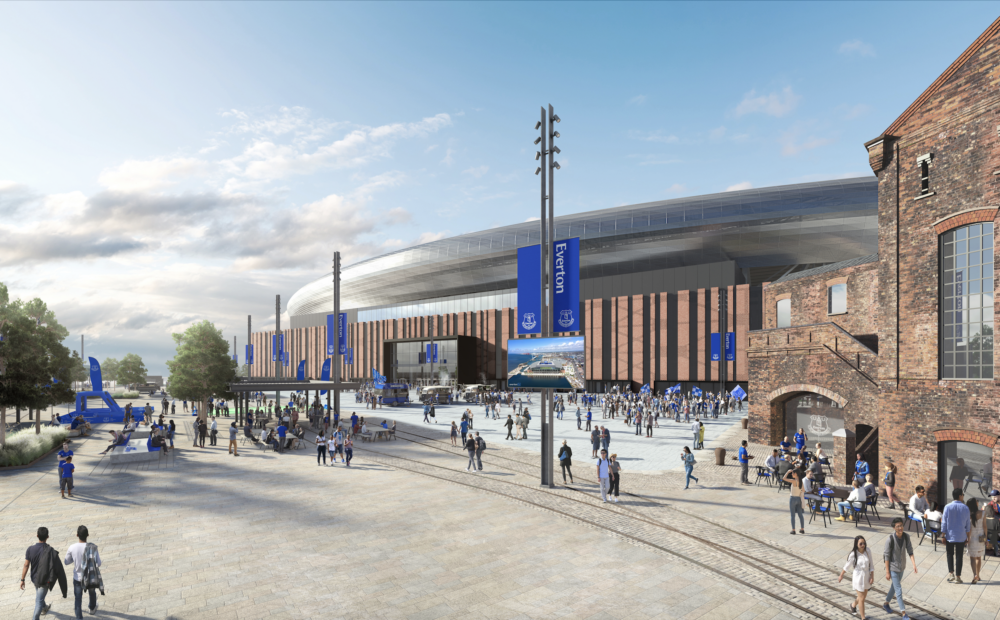
Everton FC
Everton Stadium: A game changer for the rebirth of North Liverpool
12 months ago

Everton Stadium, set on Liverpool’s iconic waterfront, is being hailed as a transformative force in the regeneration of north Liverpool.
Described as a “game changer” by Chris Capes, Development Director for Peel Waters, Everton Stadium serves as the cornerstone of the ambitious £5.5 billion Liverpool Waters development.
The stadium will transform the derelict dock spaces and breathe new life into an historic part of the city landscape.
“The stadium is an absolute game changer for us in so many ways,” he revealed.
“For us, it bookends the site, so this is the most northern part of Liverpool Waters. It creates a huge amount of footfall, and a huge amount of interest, so it just brings life to this part of the city.
“It’ll help to complete the Riverside Promenade, that runs from all the way from South Liverpool, through Pier Head, all the way north to the stadium.
“So commercially it’s going to be a game changer and economically it’s also important for this northern end of the city and Kirkdale, in terms of the creation of jobs, bringing further investment and further development into this part of Liverpool.
“Liverpool Waters also does all that and will continue to do that once the stadium is complete and you’ve got Everton playing here.”

The Liverpool Waters scheme – the biggest regeneration scheme in the North West of England – will play a significant part in future matchdays and the further regeneration of North Liverpool. A three-year programme of infrastructure will see the dockland south of Everton Stadium redeveloped, attracting new commercial opportunities, tourist facilities and open spaces.
Capes explained: “The docklands are a place where Liverpool is tied with the rest of the world and it’s incredibly important that we develop it and get that development right for the people of Liverpool.
“Obviously, the stadium is a huge part of the Liverpool Waters development. We already have 1,200 new homes that have been delivered over the past five to six years and there’s another big residential scheme currently coming out of the ground, being delivered by Vermont.
“We’ve also got the Isle of Man Ferry Terminal which opened last summer, and we secured planning permission last year to deliver central docks, which is 2,500 homes, a two-hectare park and all the infrastructure that sits alongside it, as well as commercial and community facilities.
“So that’s our big regeneration play at the moment for Peel and we’ll start on the ground in the next six months and it will be delivered over the next two and a half years.”
Everton Stadium has already played a key part in Liverpool City Region’s economic recovery from the pandemic, not only by acting as the catalyst for more than £650m worth of accelerated regeneration within Liverpool Waters and the Ten Streets developments, but also helping drive the city centre further north.
The largest single-site private sector development in the UK will contribute an estimated £1.3bn to the UK economy, create more than 15,000 jobs and attract 1.4m visitors to the Liverpool City Region, annually.
Over £250m has been spent through the local supply chain, creating opportunities for local businesses, alongside £32m worth of income for local families working on the new developments.
The stadium will also generate a return of £2.2m to Liverpool City Council through Council Tax from the wider development – money that can be spent on frontline services.
“We came when there was nothing here and it was just the open dock, so to see the stadium now is absolutely phenomenal, “ added Capes.
“It’s great for the city, but fantastic that is really starting to see more development taking place.
“When we’ve been out and consulted and done a lot of engagement with the people who live around here, they’re really keen to see access to the site, to the waterfront, and see facilities that they can use, whether it’s parks, open space, doctors, dentists, things like that, retail and other opportunities.
“It [Liverpool Waters] is a big site, stretching about two and a half kilometres down to the Royal Liver Building, so there’s an opportunity to deliver all sorts of different types of regeneration and it will be publicly accessible, all open to the public to use.
“We’ve got further 20 years of Liverpool Waters that they’re planning to deliver, so it’s not going to happen overnight, but we’re already very much on with plans, working with developers and working with hoteliers to bring them into this part of the city.”
The construction phase of Everton Stadium is due for completion by the end of 2024. The Club will play its first competitive fixture at the new stadium in August 2025.











 Subscribe
Subscribe Follow Us
Follow Us Follow Us
Follow Us Follow Us
Follow Us Follow Us
Follow Us











